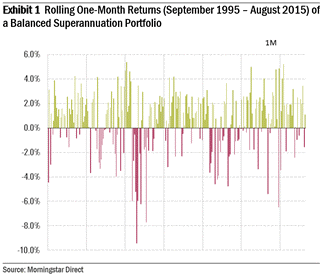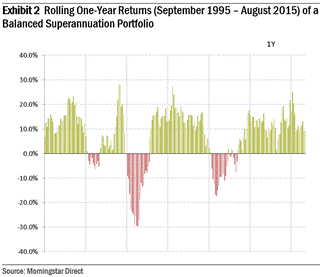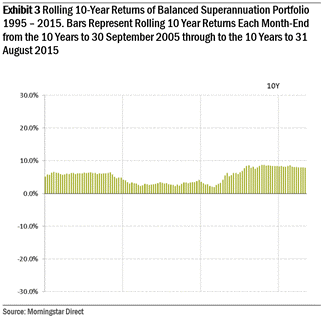No one knows what the market will do today, tomorrow, next week, next month or even next year. No one. The experts get it right about half the time, so asking them is about the same as tossing a coin. Be aware of this: when it comes to predicting short-term moves in the sharemarket the experts have a 50% chance of being right. Many people have been made to look like gurus because they correctly called ‘heads.’
Short term investing looks like this:

The green bars are the good months. The red bars are the bad months.
Short term investing is a random chaotic jungle. This is because of timing risk. Timing risk makes short term investing unpredictable and unstable. There is nothing you can do about this. Diversification does not help. It’s just the way it is.
Now throw your ‘investment eye’ out over a (rolling) year. Or ten. Things change. Patterns emerge. Almost trends. It’s not as noisy. Not as chaotic. The underlying economic relationships manifest, and performances start to regress to the mean.
It’s more predictable and more stable. But not perfectly. Investing with a rolling one year time frame is still very risky. It looks like this:

So, taking a 12 month timeframe is less risky than taking one month timeframe. Now throw your eye over a rolling ten-year average. Relationships and trends become crystal clear. Growth assets, ie property and shares, will on average in the long run earn more than the risk-free rate of return. Risk takers must be compensated, or else they will not take risks. It’s basic economics and it’s called ‘the capitalist system.’ Australia’s economy is still, despite everything you might hear about the welfare state, a predominately capitalist system.
The ten-year rolling average looks like this:

It’s now almost serene. The chaos and instability has gone. It’s very predictable. Anyone (one does not have to be an expert) can safely say that it is probable, but not certain, that a balanced portfolio will return somewhere between 4 % and 8% a year in any given ten-year period.
There are no negative ten-year periods. As we saw above, there were plenty of negative years, and even more negative months, but as time goes by their effect is always outweighed by the positive periods. There is safety in time. Time is the investor’s friend.
This is why clients should always start with a minimum holding period of at least ten years before they invest directly or indirectly in shares or property.
The authors note the influence of the article “Long-term investing: the destination is better than the journey” by Peter Gee, a research products manager with Morningstar Australasia, published in www.cuffelinks.com.au on 10 December 2015. We borrowed their graphs as well.
You can read the original article here: Long term investing: the destination is better than the journey.




